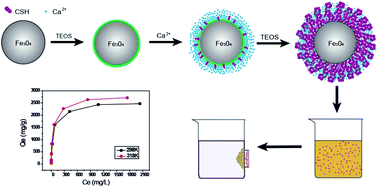Preparation of magnetic calcium silicate hydrate for the efficient removal of uranium from aqueous systems†
Abstract
To obtain an adsorbent for uranium with superb adsorption capacity, a rapid adsorption rate and quick magnetic separation, magnetic calcium silicate hydrate (MCSH) is fabricated through in situ growth of calcium silicate hydrate (CSH) onto the surface of the magnetic silica microspheres via a sonochemical method. The chemical components, and structural and morphological properties of MCSH are characterized by FTIR, XRD, TG, VSM, SEM, TEM and N2 adsorption–desorption methods. The results show that MCSH with a mesoporous structure is constructed by an agglomeration of CSH nanosheets. The BET specific surface area and saturation magnetization of MCSH are determined to be 196 m2 g−1 and 15.4 emu g−1, respectively. Based on the synthetic MSCH, adsorption isotherms, thermodynamics and kinetics are investigated. The adsorption mechanism fits the Langmuir isotherm model with a maximum adsorption capacity of 2500 mg g−1 at 298 K. The calculated thermodynamic parameters demonstrate that the adsorption process, which is in accordance with a pseudo-second-order model, is spontaneous and endothermic. MCSH exhibits a quick and highly efficient adsorption behavior, and more than 80% of uranium (1000 mg L−1) is adsorbed in the first 10 min. The superb adsorption capacity and rapid adsorption rate are likely attributed to the ultrahigh specific surface area and facile exchanges of uranium ions and calcium ions of CSH ultrathin nanosheets. These results demonstrate that MSCH is an excellent adsorbent for uranium removal from aqueous systems.


 Please wait while we load your content...
Please wait while we load your content...